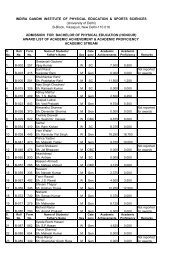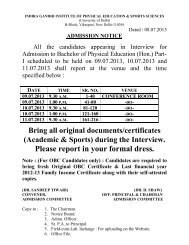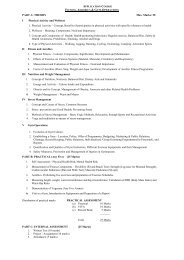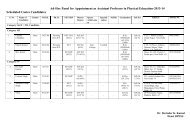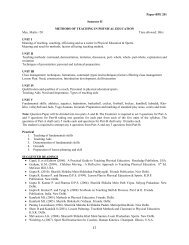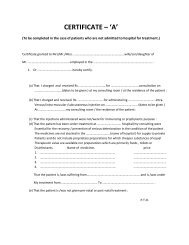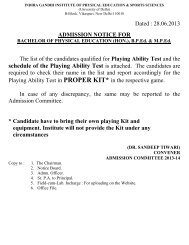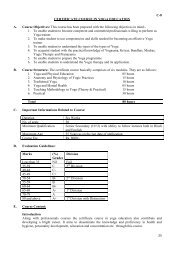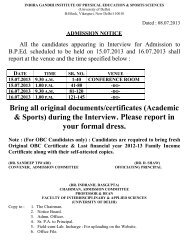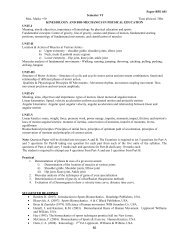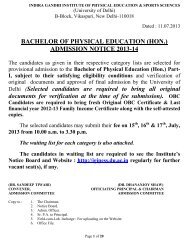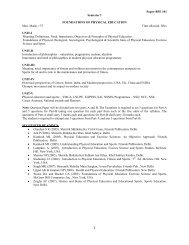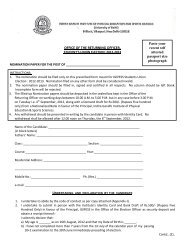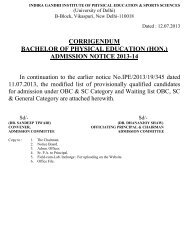Semester III - Indira Gandhi Institute of Physical Education and ...
Semester III - Indira Gandhi Institute of Physical Education and ...
Semester III - Indira Gandhi Institute of Physical Education and ...
Create successful ePaper yourself
Turn your PDF publications into a flip-book with our unique Google optimized e-Paper software.
Paper-BPE 302<br />
<strong>Semester</strong> <strong>III</strong><br />
Max. Marks =50<br />
Time allowed: 3Hrs<br />
HEALTH EDUCATION, FIRST AID & REHABILITATION<br />
Unit-I<br />
Health-meaning, dimensions <strong>of</strong> health <strong>and</strong> their interrelationships, importance <strong>of</strong> health for individual, family,<br />
community <strong>and</strong> nation; factors influencing health, spectrum <strong>of</strong> health<br />
Health <strong>Education</strong>- meaning, scope, aims <strong>and</strong> objectives, principles, methods <strong>and</strong> media used in health education<br />
Hygiene- personal hygiene, food hygiene, environmental hygiene-meaning, need <strong>and</strong> importance; associated<br />
practices related to maintenance <strong>and</strong> promotion <strong>of</strong> health<br />
Unit-II<br />
Foods <strong>and</strong> Nutrition- Misconceptions about food, essential body nutrients- functions, food sources, balanced diet,<br />
diet prescription<br />
Communicable <strong>and</strong> Non-communicable diseases- meaning, distinction between communicable <strong>and</strong> noncommunicable<br />
diseases. Communicable diseases- their mode <strong>of</strong> spread <strong>and</strong> prevention <strong>of</strong> diarrhea diseases, typhoid,<br />
malaria, STD Respiratory disease ; non-communicable diseases- causes <strong>and</strong> prevention <strong>of</strong> diabetes, CVD, cancers,<br />
renal diseases <strong>and</strong> respiratory diseases.<br />
Unit-<strong>III</strong><br />
Contemporary health problems <strong>of</strong> college youth- Alcohol, drugs, use <strong>of</strong> tobacco (chewing, sniffing, smoking)- their<br />
harmful effects substance abuse management<br />
Population education- importance <strong>of</strong> small family, methods <strong>of</strong> controlling conception, signs <strong>and</strong> symptoms <strong>of</strong><br />
pregnancy, home <strong>and</strong> hospital delivery, care <strong>of</strong> the infant, importance <strong>of</strong> breast feeding, immunization, oral<br />
rehydration therapy<br />
National health programmes- components <strong>of</strong> existing national health programmes<br />
Unit-IV<br />
Definition <strong>of</strong> first aid, DRABCH <strong>of</strong> first aid, CPR, first aid for, hemorrhage, fractures, sprain <strong>and</strong> strain (Price),<br />
drowing snake bite, poisoning, heat stroke <strong>and</strong> heat exhaustion<br />
Internationals health agencies- WHO, UNICEF, Red Cross- their constitution <strong>and</strong> role in promoting health<br />
Unit-V<br />
Rehabilitation – definition, physical, mental <strong>and</strong> psychological rehabilitation.<br />
Rehabilitation Modalities – cold, heat, water, radiation, Hydrotherapy, cryotherapy, thermotherapy – superficial heat<br />
– I R Lamp, Wax bath, deep heat- short wave diathermy, microwave diathermy, u/s therapy, inferential therapy,<br />
TENS, nerve muscle stimulator.<br />
Note: Question Paper will be divided into two parts A <strong>and</strong> B. The Examiner is required to set 5 questions for Part-A<br />
<strong>and</strong> 5 questions for Part-B taking one question for each part from each <strong>of</strong> the five units <strong>of</strong> the syllabus. The<br />
questions <strong>of</strong> Part-A shall carry 5 marks each <strong>and</strong> questions for Part-B shall carry 10 marks each.<br />
The student is required to attempt any 4 questions from Part-A <strong>and</strong> any 3 questions from Part-B.<br />
Practical<br />
1. A visit to – International health agency <strong>and</strong>/or Government/NGO related to health promotion activities<br />
2. Study <strong>of</strong> health programmes/s<br />
3. Prescription <strong>of</strong> diet<br />
4. Determination <strong>of</strong> calorie value <strong>of</strong> food<br />
5. Identification <strong>of</strong> various methods <strong>of</strong> contraceptives<br />
6. Collection <strong>of</strong> material for substance abuse control<br />
7. Immunization schedule<br />
SUGGESTED READINGS<br />
Anspaugh DJ Ezell G <strong>and</strong> Goodman KN (2006). Teaching Today’s Health. Mosby Publishers. Chicago.<br />
USA.<br />
Balayan D (2007). Swasthya Shiksha Evam Prathmik Chikitsa. Khel Sahitya. Delhi.<br />
Chopra D <strong>and</strong> D Simon (2001). Grow Younger, Live Longer: 10 Steps to Reverse Aging. Three Rivers<br />
Press. New York. USA.<br />
Dewan AP (1996). School Health Manual. Nature Cure <strong>and</strong> Yoga Health Centre. New Delhi.<br />
Dixit Suresh (2006). Swasthya Shiksha. Sports Publication. Delhi.<br />
24



